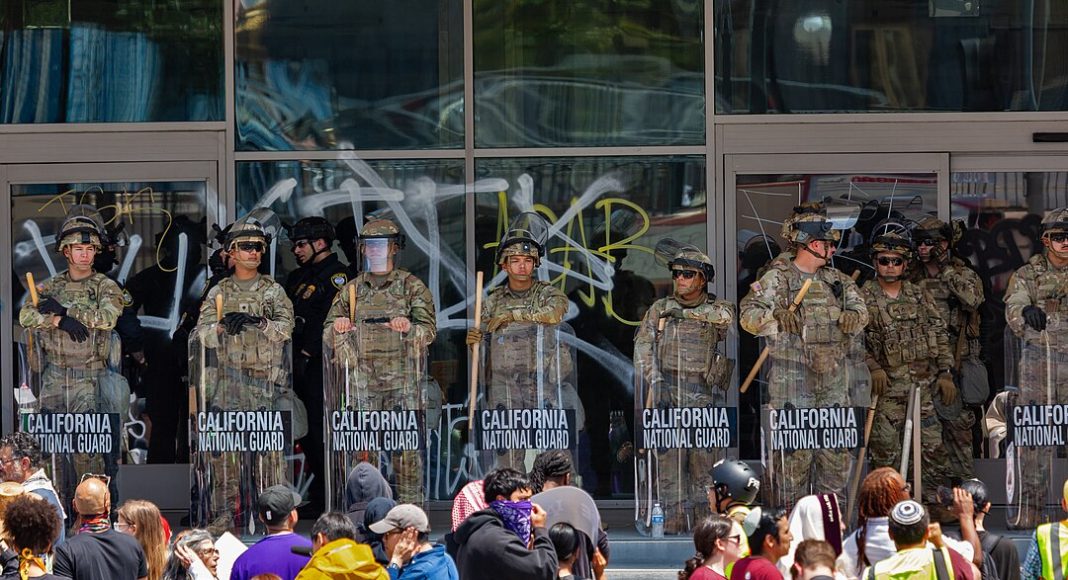In June 2025, Los Angeles, California erupted in fierce resistance against US Immigration and Customs Enforcement (ICE) raids targeting immigrant communities. On 7 June 2025, ICE agents, backed by US Federal Bureau of Investigation (FBI) personnel, carried out aggressive raids in downtown LA and Paramount, deploying tear gas and flashbang grenades against crowds of outraged residents who tried to obstruct detentions. This triggered mass mobilisations with thousands pouring into the streets that same day in protest, blocking roads across the city. This most recent battle in US President Donald Trump’s increasingly brutal, racist war against migrants, indicates the lengths the administration will go to squash dissent.
LA uprising faces federal state repression
By 9 June, riot police had escalated their violent tactics, firing rubber bullets and flashbangs at protesters, injuring dozens of protestors, journalists, and even bystanders. In an unprecedented move, President Trump deployed over 700 Marines to Los Angeles alongside more than 2,000 National Guardsmen. A day later, the Pentagon sent in another 2,000 National Guard troops, bringing the total military personnel to nearly 5,000. Historically, the National Guard is called on by state officials in a ‘state of emergency’, not by federal powers, including the president. This move has sparked a backlash from the public, with even the Governor of California, Gavin Newsom, recognising this move as an overstep of executive power. His concern, however, was with unnecessary expenditure of resources, rather than the violent attacks on migrants and protestors that the troops and police carried out in the streets of California.
Undeterred by the military intimidation and violence, more than ten thousand people marched through downtown LA, demanding an end to the raids and withdrawal of military forces, while crowds rallied outside the downtown detention centres in support of migrants.
By mid-June, large-scale protests and uprisings had settled down, but ICE’s terror raids and resistance continued through July. Farmworkers in Camarillo, California faced a militarized raid on Glasshouse Farm on 10 July, resulting in severe injuries and the death of Jaime Alanís Garcia, a Mexican farmworker who fell 30 feet to his death trying to escape the chaos unleashed by ICE. His death was widely condemned and it prompted Mexico’s President Claudia Sheinbaum to consider legal action against the Trump administration.
The protests spread
The images of state violence and fierce resistance coming out of California sparked protests in solidarity across the country throughout the same time – from Dallas to Houston, San Antonio to New York, against ICE and the use of military force against civilians. Federal workers in Chicago, Seattle and New York City held pickets standing against ICE in their workplaces and demanding an end to ICE raids in government offices which have scared away many from seeking important services. These protests were, of course, also met with violent repression; in Dallas, Texas, police pepper-sprayed clergy and legal observers and in Santa Ana, California, detainees were pepper-sprayed and beaten.
Alligator Alcatraz
On 3 July, a sprawling migrant detention camp in the Florida Everglades named ‘Alligator Alcatraz’ opened its doors after only eight days of construction on seized public land following emergency federal orders. The facility, surrounded by razor wire and alligator infested swampland, uses tents and trailers to hold thousands in deplorable conditions – backed-up toilets, maggot-infested food, insect swarms, and lack of medical care – which advocates say amount to ‘psychological terrorism’. This grotesque facility, costing $245m in initial contracts and an estimated $450m to run annually, is yet another addition to the US deportation apparatus.
ICE expansion
The US deportation regime is on a trajectory to expand even further with the 4 July signing of the ‘One Big Beautiful Bill Act’. The bill injects ICE with an unprecedented $75bn over four years, including $45bn for detention beds (adding up to 100,000 beds) and nearly $30bn to triple its current cap, hiring 10,000 new agents, expanding transportation, deportation logistics, and strengthening state and local collaboration. This would bring the ICE annual budget to roughly $28bn this year and $100bn by 2029 as the largest federal law enforcement agency in the nation, eclipsing the FBI, US Drug Enforcement Administration, US Bureau of Alcohol, Tobacco, Firearms and Explosives, US Marshals, and the US Bureau of Prisons combined. ICE functions as the US Gestapo, with the Trump administration encouraging state institutions and members of the public to serve as its vigilante agents.
All of these measures to enforce racist migration laws are not for security, but to serve the needs of capitalism by asserting control over a disposable immigrant workforce. Despite mass repression, including arrests, injuries, and deaths, the communities rising against these measures remain resilient. Protests have spread nationwide, with community members, labour unions, students and religious leaders joining forces to defend migrants.
Stop deportations now!
Soma Kisan
Fight Racism! Fight Imperialism! 307, August/September 2025




